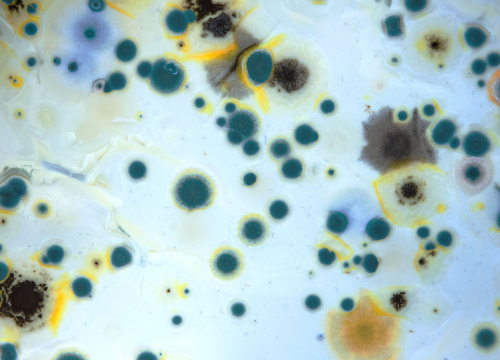Difference Between Mold and Mildew
Mold is a green or black-colored, slimy fungus that grows beneath wet damp surfaces. Mildew is a fluffy or powder-like fungus that is white, yellow, or gray and grows over the top of wet damp surfaces.

What is mold?
Definition:
Mold is a green or black-colored, slimy fungus that grows beneath wet damp surfaces.
Appearance:
Mold tends to present in darker colors like green or black which makes it distinct in appearance. It has a slimy or fuzzy texture.
Smell:
Mold has a very strong pungent smell. As the mold grows, there is the production of microbial volatile organic compounds which cause the pungent smell.
Growth:
Mold grows best underneath the damp moist surfaces which is why it is hard to get rid of. Mold can be found in kitchen cabinets, refrigerators, microwaves, bathroom tiles, and sinks.
Health effects:
Mold especially black molds have severe health risks. It can trigger respiratory problems and can cause headaches, watery eyes, nasal congestion, body aches, and mood changes.
Eradication techniques:
Mold is hard to get rid of. Harsh chemical cleaners like bleach are used to remove mold. You also need precautions like masks and gloves while handling molds. Some species of mold cannot be eliminated without hiring a mold removal professional.

What is mildew?
Definition:
Mildew is a fluffy or powder-like fungus that is white, yellow, or gray and grows over the top of wet damp surfaces.
Appearance:
Mildew appears powdery and is white, yellow, or gray.
Smell:
Mildew has a musty smell that is similar to that of damp socks.
Growth:
Mildew grows best in humid temperatures. It is a fungus that spreads on surfaces and not underneath. A humidity of 60-90 percent and high temperatures of 77-88 degrees are the most optimum for the growth of mildew. Because of this reason, mildew is seen in places like shower walls and windowsills.
Health effects:
Mildew does not cause severe health effects however people may experience sore throats and headaches from mildew.
Eradication techniques:
Mildew can easily be eliminated by using household cleaning equipment like scrubbing brushes and cleaners. It is easy to scrap off as it exists on the surfaces.
Difference Between Mold and Mildew
Definition:
Mold is a green or black-colored, slimy fungus that grows beneath wet damp surfaces. Mildew is a fluffy or powder-like fungus that is white, yellow, or gray and grows over the top of wet damp surfaces.
Appearance:
Mold tends to present in darker colors like green or black which makes it distinct in appearance. It has a slimy or fuzzy texture. Mildew appears powdery and is white, yellow, or gray.
Smell:
Mold has a very strong pungent smell. As the mold grows, there is a production of microbial volatile organic compounds which cause the pungent smell. Mildew has a musty smell that is similar to that of damp socks.
Growth:
Mold grows best underneath the damp moist surfaces which is why it is hard to get rid of. Mold can be found in kitchen cabinets, refrigerators, microwaves, bathroom tiles, and sinks. Mildew grows best in humid temperatures. It is a fungus that spreads on surfaces and not underneath. A humidity of 60-90 percent and high temperatures of 77-88 degrees are the most optimum for the growth of mildew. Because of this reason, mildew is seen in places like shower walls and windowsills.
Health effects:
Mold, especially black molds, have severe health risks. It can trigger respiratory problems and can cause headaches, watery eyes, nasal congestion, body aches, and mood changes.
Mildew does not cause severe health effects however people may experience sore throats and headaches from mildew.
Eradication techniques:
Mildew can easily be eliminated by using household cleaning equipment like scrubbing brushes and cleaners. It is easy to scrap off as it exists on the surfaces.
Mold is hard to get rid of. Harsh chemical cleaners like bleach are used to remove mold. You also need precautions like masks and gloves while handling molds. Some species of mold cannot be eliminated without hiring a mold removal professional.
Table of differences between Mold and Mildew

FAQs
How do I know if it’s mold or mildew?
Mold is a green or black-colored, slimy fungus that grows beneath wet damp surfaces. Mildew is a fluffy or powder-like fungus that is white, yellow, or gray and grows over the top of wet damp surfaces.
Is mildew as harmful as mold?
Mildew does not cause serious health effects however people may experience sore throats and headaches from mildew.
Can you have mildew without mold?
Yes.
How long does it take for mold to turn into mildew?
Mold does not change to mildew.
Can mildew make you sick?
Yes. People may experience sore throats and headaches with mildew.
How to get rid of mildew?
Mildew can easily be eliminated by using household cleaning equipment like scrubbing brushes and cleaners. It is easy to scrap off as it exists on the surfaces.
Does vinegar destroy mildew?
Yes.
Can you remove mildew yourself?
Yes, it can be scrapped.
What kills mildew naturally?
Hydrogen peroxide can kill mildew.
- Differences Between Reptiles and Amphibians - May 17, 2024
- Difference Between Ophthalmology and Optometry - May 15, 2024
- Difference Between Fear and Anxiety - April 2, 2024
Search DifferenceBetween.net :
Leave a Response
References :
[0]Bush, Robert K., et al. "The medical effects of mold exposure." Journal of Allergy and Clinical Immunology 117.2 (2006): 326-333.
[1]Salvaggio, John, and Lars Aukrust. "Mold-induced asthma." Journal of Allergy and Clinical Immunology 68.5 (1981): 327-346.
[2]Fondevilla, Sara, and Diego Rubiales. "Powdery mildew control in pea. A review." Agronomy for sustainable development 32 (2012): 401-409.
[3]Image credit: https://www.canva.com/photos/MAEmCgCurNI-mold-milk-mold-mold-cultures-multi-colored-molds/
[4]Image credit: https://www.canva.com/photos/MADP-8Sve58-detail-of-powdery-mildew/
